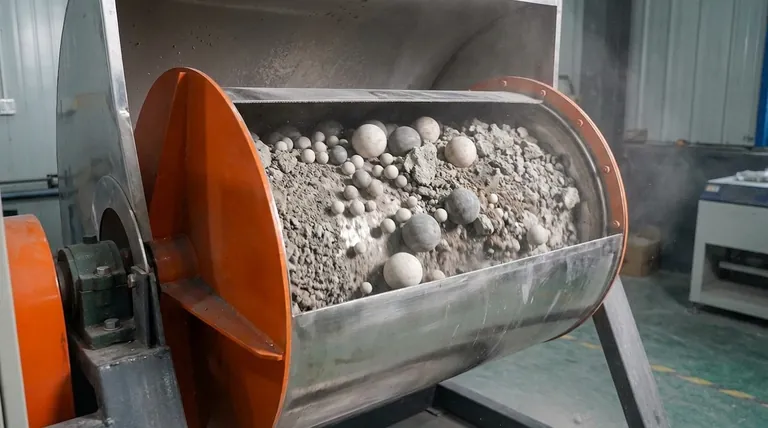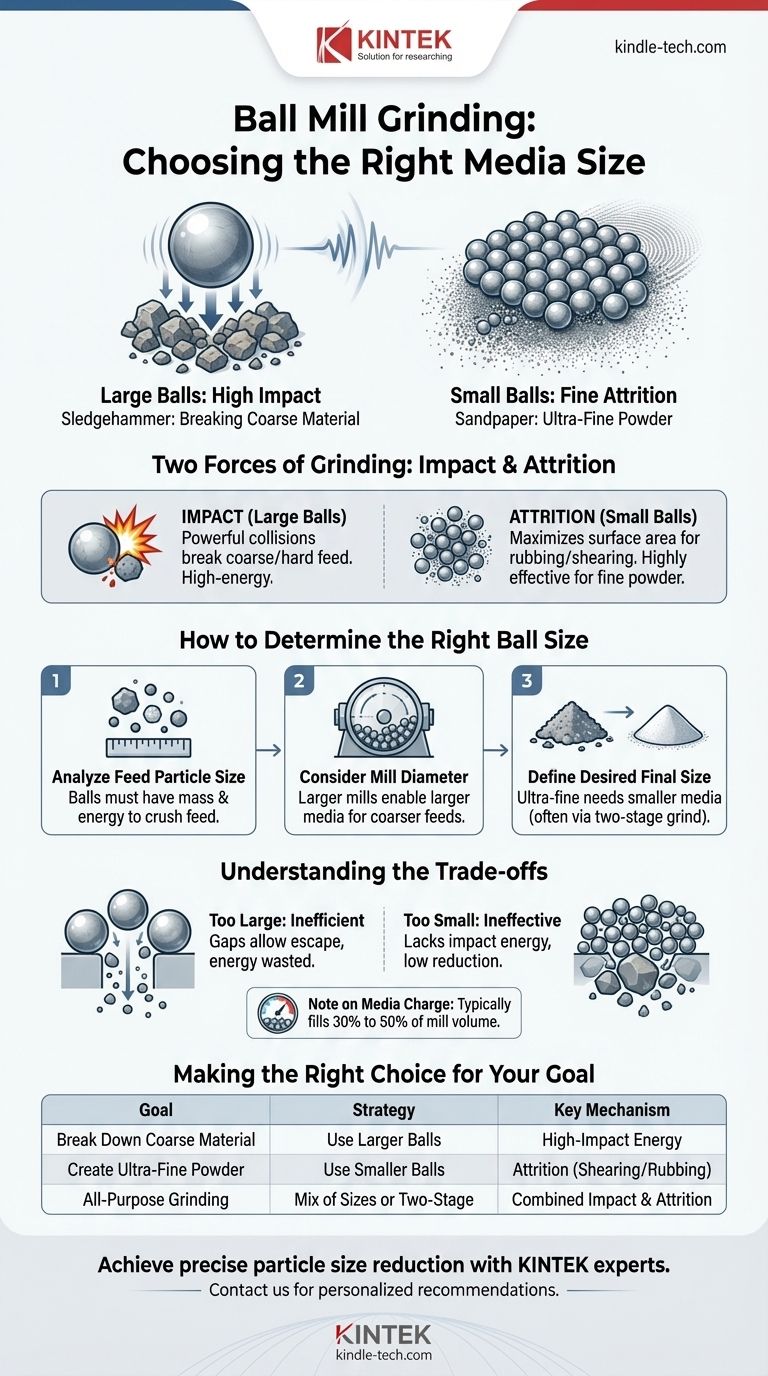The right ball size for a ball mill is determined by a critical balance between the size of the material you are grinding and the diameter of your mill. As a starting point, the grinding media must be significantly larger and heavier than the largest particles of the feed material to effectively break them down through impact.
The core principle is that optimal grinding requires a careful trade-off. You need balls large enough to provide the impact force necessary to fracture your initial material, yet small enough to create the surface area required for fine, attritional grinding.

The Two Forces of Grinding: Impact and Attrition
The entire purpose of the grinding media is to facilitate size reduction. This happens through two primary mechanisms, and your choice of ball size directly influences which one dominates.
Large Balls for High Impact
Larger, heavier balls create more powerful collisions when they are lifted and fall inside the mill. This high-energy impact is essential for breaking down coarse, large, or very hard feed particles.
Think of it as using a sledgehammer; it's designed for breaking large rocks, not for fine shaping.
Small Balls for Fine Attrition
A charge of smaller balls has a vastly greater total surface area than an equal volume of large balls. This maximizes the rubbing and shearing action, known as attrition, which is highly effective for grinding already small particles into a very fine powder.
This is like using sandpaper; its effectiveness comes from countless small points of contact, not a single massive impact.
How to Determine the Right Ball Size
There isn't a single universal size, but a logical process for determining the best fit for your application. The key is to match the media to the material and the mill itself.
The Critical Link: Feed Particle Size
The most important factor is the size of the material you are putting into the mill. The balls must have enough mass and kinetic energy to crush the particles. If the balls are too small, they will simply be pushed aside by the larger feed material.
Considering Mill Diameter
The diameter of the mill cylinder directly affects the energy of the process. A larger diameter mill lifts the balls higher before they fall, generating greater impact velocity and force.
Therefore, larger mills can effectively utilize larger grinding media to process coarser feeds.
The Goal: Desired Final Particle Size
If your objective is to produce an ultra-fine powder, you will eventually need smaller grinding media. Often, the most efficient process is a two-stage grind: first, use larger balls to break down the coarse feed, then replace them with smaller balls to achieve the final desired fineness through attrition.
Understanding the Trade-offs
Choosing the wrong size media is a common source of inefficiency and poor results in ball milling.
The Problem with Balls That Are Too Large
If your grinding media is excessively large for the feed material, the process becomes inefficient. The large gaps between the balls allow smaller particles to escape the grinding action, and you expend significant energy moving heavy media that isn't performing effective work.
The Problem with Balls That Are Too Small
Conversely, if the balls are too small, they will lack the impact energy to break down the initial feed material. This results in extremely long milling times or a complete failure to reduce the particle size, no matter how long the mill runs.
A Note on Media Charge
Ball size is only part of the equation. The media charge, or the total volume the balls occupy in the mill, is also critical. A typical charge fills 30% to 50% of the mill's internal volume to ensure there are enough contact points for efficient grinding.
Making the Right Choice for Your Goal
To select the correct media, always start by analyzing your material and your objective.
- If your primary focus is breaking down large, coarse material: Choose larger balls that provide the necessary high-impact energy to fracture the feed particles.
- If your primary focus is creating an ultra-fine powder from smaller particles: Use a charge of smaller balls to maximize surface area and promote efficient attritional grinding.
- If your primary focus is all-purpose grinding: Consider a mixed charge of various sizes or a two-stage process, starting large and finishing small.
Matching your grinding media to your specific application is the most important step toward achieving efficient and effective size reduction.
Summary Table:
| Goal | Recommended Ball Size Strategy | Key Mechanism |
|---|---|---|
| Break Down Coarse Material | Use larger balls | High-Impact Energy |
| Create Ultra-Fine Powder | Use smaller balls | Attrition (Shearing/Rubbing) |
| All-Purpose Grinding | Use a mix of sizes or a two-stage process | Combined Impact & Attrition |
Achieve precise and efficient particle size reduction with the right grinding media. The experts at KINTEK can help you select the optimal ball size and type for your specific material and mill to maximize your lab's productivity and results. Contact our team today to discuss your application and get a personalized recommendation for your laboratory equipment needs.
Visual Guide

Related Products
- Stainless Steel Laboratory Ball Mill for Dry Powder and Liquid with Ceramic Polyurethane Lining
- Laboratory Ball Mill Jar Mill with Metal Alloy Grinding Jar and Balls
- Laboratory Single Horizontal Jar Mill
- Laboratory Horizontal Planetary Ball Mill Milling Machine
- High-Energy Omnidirectional Planetary Ball Mill Milling Machine for Laboratory
People Also Ask
- What are the main components of a ball mill? Optimize Your Grinding Process for Peak Performance
- What are the disadvantages of a ball mill? High Energy Use, Noise, and Contamination Risks
- What is the theory of ball milling? Mastering Particle Size Reduction Through Impact and Attrition
- What is the effect of ball size in ball milling? Optimize Particle Size and Reaction Efficiency
- What is the major limitation of ball mill? Ineffectiveness with soft, tacky, or fibrous materials



















